 When he was a young man in his mid-twenties, future Roman leader Julius Caesar was voyaging across the Mediterranean Sea. Pirates swarmed over his ship. They took him to their base on tiny Farmakonisi Island, which lies off the coast of Asia Minor (modern-day Turkey), and held him for ransom. When he learned how much the pirates were demanding for his release, Caesar laughed. Do you have any idea who I am, he asked. I belong to one of Rome’s most important families. So you can get more money for me—a lot more—almost three times as much. The astonished pirates were only too happy to oblige him. Keeping a friend and two servants with him on Farmakonisi, Caesar ordered the rest of his traveling party to go to Asia Minor and raise his ransom. While they were doing that, Caesar acted as if he were the ruler of the tiny island, rather than a captive cowering in fright. He ordered the pirates to attend lectures and poetry readings he gave, and prodded those who nodded off as he droned on and on and on. When he wanted to sleep, he ordered the pirates to either speak in whispers or go to another part of the island. He even played games with them. He also told them that when he was released, I promise I will hunt you down and execute you. In the spirit of bonhomie he engendered, the pirates apparently thought he was joking. He wasn’t. Though outwardly he was friendly with the pirates, he seethed inwardly at the humiliation of being taken prisoner. After the ransom was paid, Caesar sailed to a nearby port. He raised a fleet of ships and scores of armed men. He returned to Farmakonisi, captured the pirates, and reclaimed the ransom money. He threw his former captors into prison. They didn’t stay there long. Caesar crucified them. He did show some mercy. Since crucifixion was a long, lingering death, he cut their throats so they died instantly.  MLA 8 Citation
Whiting, Jim. "A Man of His Word." Nonfiction Minute, iNK Think Tank, 26 Mar. 2018, www.nonfictionminute.org/the-nonfiction-minute/A-Man-of-his-Word.
1 Comment
Do you ever stop to think how your everyday life has been shaped by people from the past? Well, if you play the guitar, brush your teeth, or eat dessert after a meal, you owe a debt of gratitude to a Muslim musician who lived twelve hundred years ago. Abul-Hasan, a commoner born in Baghdad around 789 A.D., had a gift for song that so pleased the ruling caliph he gave him the name “Ziryab,” meaning “Blackbird." Ziryab’s natural musical talent made other musicians jealous, however. So, when the caliph died in 813, they exiled the "Blackbird," sending him to wander the Islamic world for a decade. He performed wherever he went and picked up customs from the people he met. Ziryab eventually found his way to Al-Andalus (today’s Andalusia, Spain). Its ruler loved music. In fact, he valued musicians above all other professionals. He welcomed the refugee. He offered him asylum. Ziryab was an instant sensation. He introduced his instrument, the Baghdadi oud, to his new neighbors. Then, adding an extra string to his oud, he ignited the evolution of the Spanish guitar. He established the first-ever music conservatory in Córdoba, which gave rise to the genre of Andalusian classical music--musiqa al-ala—that is still a popular in Morocco today. But Ziryab's influence didn't stop with music. He transformed Córdoban society as well. He taught locals how to make deodorant and toothpaste. He instructed women in how to shape eyebrows, cut their hair into bangs, remove unwanted body hair. He inspired men to shorten their hair, as well, and to shave daily. And instead of piling his food onto platters, as was then the custom, Ziryab ate his meals atop a clean tablecloth and in three distinct courses: a soup, a main dish, and a dessert. So each time you sit down to a three-course dinner, strum your six-string guitar, brush your teeth, or tidy your hair, you are following in the footsteps of a Muslim musician who lived 1,200 years ago. 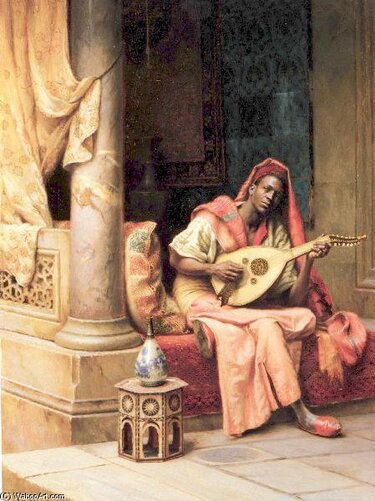 In music, Ziryab was the first to introduce the lute (Al-U'd) to Spain and Europe in general. He is credited with the addition of the fifth bass string to it which later paved the way for the development of the guitar. He also established the first conservatory in the world that included the teaching of harmony and composition.  Sarah Towle is an award-winning digital storyteller of immersive tales for educational tourism. With her latest project for secondary school students—the History Hero BLAST—she puts the Story back in History, bringing a fictional flair to factual tales of inspirational figures from around the world and throughout time. A blog and future podcast, the HHBLAST welcomes the participation of published and aspiring authors, including young writers. Click here to find out more Ziryab and other History Heroes and about how to bring the HHBLAST—and Sarah—to your school! 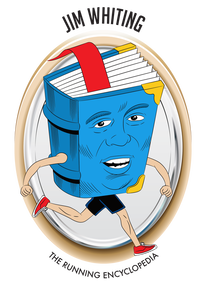 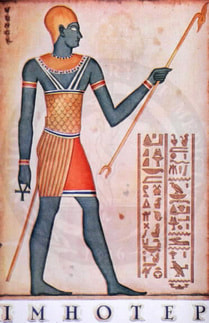 The Renaissance began in Europe in the 15th century and marked the change from the medieval period to the modern world. Towering figures such as Michelangelo, Galileo, and especially Leonardo da Vinci were known as Renaissance men because of their talents and lasting achievements in several important areas of knowledge. They were also accomplished musicians, public speakers, athletes, poets, and so forth. And they were expected to do all this stuff without breaking a sweat. You could give the same title to an ancient Egyptian named Imhotep, who lived about 2600 BCE. He was the vizier, the most important government official, during the reign of Pharaoh Djoser. He served as the high priest of the god Ra and was an expert astronomer. Imhotep designed and oversaw the building of the first major pyramid in Egypt. Located at Saqqara, at the time it was the world’s tallest structure. He innovated the use of stones rather than mud bricks to build it, and it was that added strength that enabled the pyramid to rise so high. He is also credited with the invention of several devices that facilitated the construction. Many people believe that Imhotep, rather than the Greek Hippocrates who lived more than 2,000 years later, is the real “Father of Medicine.” In an era when most physicians relied on magic spells and appeals to the gods, Imhotep prescribed dozens of effective down-to-earth treatments for illnesses and injuries. He is credited with ending a seven-year famine in Egypt. He advised the pharaoh to make sacrifices to Khnum, the god of the annual flooding of the Nile River, and thereby provide desperately needed water to farmers. On a more practical level, he invented an improved irrigation system to carry water to the crops even if the river level was abnormally low. In addition to these accomplishments, an inscription at the base of one of his statues notes that he was “Chief Carpenter, Chief Sculptor, and Maker of Vases in Chief.” In his little spare time, he wrote poetry and dispensed philosophical advice. Imhotep can also boast of two accomplishments that eluded even Leonardo da Vinci. He was deified after his death and worshipped for many centuries, an honor accorded to hardly anyone besides the pharaohs. And today the comic book community gives him the credit for founding S.H.I.E.L.D., the Marvel Comics espionage and crime-fighting agency that became the basis for blockbuster movies such as Iron Man, Thor, and Captain America. 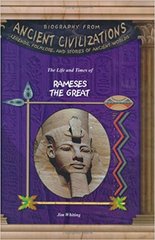 Jim Whiting has written a book on another great Egyptian leader -- Ramses the Great who lived about 1350 years after Imhotep. He fully lived up to the "Great" part of his name. His reign lasted for 67 years, the second longest in Egypt’s 3,000-year history. He had dozens of wives and more than 100 children, outliving many of them. He was a military leader who expanded the borders of his country. That resulted in decades of peace and prosperity for his people. He ordered huge statues of himself to be erected all over Egypt. For more information, click here. MLA 8 Citation
Whiting, Jim. "A Renaissance Man - 4,000 Years before the Renaissance." Nonfiction Minute`, iNK Think Tank, 8 Feb. 2018, www.nonfictionminute.org/the-nonfiction-minute/ A-Renaissance-Man-4,000-Years-Before-the-Renaissance. 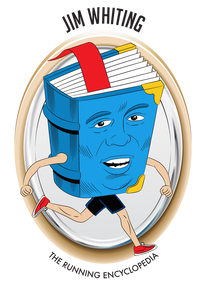 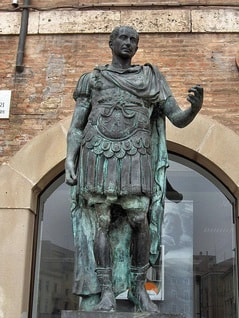 Julius Caesar Julius Caesar When Julius Caesar took control of the Roman government, he decided to reform the calendar. Because it was a lunar calendar—based on complete cycles of the moon—it had fluctuated widely for centuries. Some years had as few as 355 days while others nudged 380, often seemingly by whim. After lengthy consultations with the Egyptian astronomer Sosigenes, Caesar established a calendar that is virtually the same one we use today. The lengths of the months alternated between 30 and 31 days, except February which had 29. The new calendar came into effect on January 1, 45 BCE (Before the Common Era). A grateful Roman Senate immediately changed the name of the month of Quintilis—Julius Caesar’s birth month—to July in his honor. As is the case today, it had 31 days. Caesar had only one year to enjoy “his” month, as he was assassinated the following March. His successor was his grand-nephew Octavian, who took the name of Augustus Caesar when he officially became the first Roman emperor. In 8 BCE the Senate decided that he also deserved a month. Because several noteworthy events during Augustus’s reign had occurred in Sextilis, the month following July, they chose it. Big problem. Sextillis had only 30 days. No way would the Senate allow Augustus to be “inferior” to his great-uncle in any way. So it took a day from February and tacked it on at the end of August. That created another problem. Three consecutive months—July, August, and September—were now 31 days long. The fix was simple: the Senate simply flipped the lengths of the remaining four months. September and November went from 31 days to 30, while October and December bulked up to 31. The Senate wasn’t finished with its tinkering. Nearly 70 years later, it honored the notorious emperor Nero by changing Aprilis to Neronius. The new name never gained traction. Nero. who had murdered his brother, mother, and wife, committed suicide in 68 CE (Common Era). The Senate—undoubtedly relieved at his demise—hastily returned Neronius to its original name. 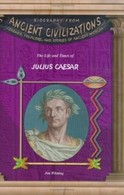 Here is Jim's biography of Julius Caesar, who became a very successful military commander who added more than 200,000 square miles to the territories under Rome’s control. But his triumphs created powerful enemies in Rome. Eventually he was assassinated in the Roman Senate. MLA 8 CItation
Whiting, Jim. "July, August and Neronius." Nonfiction Minute, iNK Think Tank, 14 Nov. 2017, www.nonfictionminute.org/july-august-and-neronius. 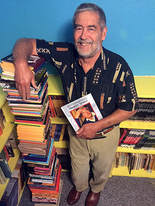 When the Seleucid emperor Antiochus IV came to power in 175 BCE after his brother was assassinated, he insisted on being called Antiochus Epiphanes (“Antiochus the Visible God”). To the Jews who had the misfortune to be among his subjects, he was Antiochus Epimanes (“Antiochus the lunatic”). No matter his name, he was definitely bad news to the Jews. Because of his Greek background, Antiochus believed in many gods. The Jews, on the other hand, were monotheistic. Antiochus soon began imposing his beliefs on the Jews and making it much more difficult for them to practice their religion. For example, anyone caught circumcising their newborn children would be put to death. In 168 he sacked Jerusalem. His forces cut down thousands of defenseless Jews of all ages, looted and desecrated the Second Temple, and erected a massive statue of the chief Greek god Zeus (using himself as a model for the sculptor who created the statue). Soon the altar ran red with the blood of swine that were slaughtered as sacrifices. For good measure, Antiochus also outlawed the Hebrew religion. The outraged Jews fought back. An elderly priest named Mattathias and some of his men killed a group of Seleucid soldiers. That ignited a revolt against Antiochus’s rule. When Mattathias died, his son Judah assumed the leadership role. Judah soon acquired the surname of Maccabee (“the hammer”) for his skill in battle. After a series of successful guerrilla operations, he led his vastly outnumbered forces to two decisive victories that resulted in the recapture of Jerusalem in 165. The first order of business was cleansing the temple so it could be rededicated. The ceremony began on the 25th day of the Hebrew month of Kislev. According to legend, the small amount of purified oil that was readily available for the rites was expected to burn just a single night. Instead it burned for eight nights, when a new supply became available. That miracle gave rise to the ceremony of lighting one candle for each of the eight nights of Hanukkah, which means “dedication.” Because the Hebrew calendar is lunar-based, the dates of Hanukkah change each year. This year Hanukkah begins [December 12] at sunset and lasts until sunset on December [20]. To the Jewish families who celebrate the holiday, Happy Hanukkah!  The holidays are approaching and millions of people will be listening to Handel’s Messiah. Read all about the composer in Jim Whiting’s Masters of Music biography. MLA 8 Citation
Whiting, Jim. "The Story of Hanukkah." Nonfiction Minute, iNK Think Tank, 11 Dec. 2017, www.nonfictionminute.org/the-story-of-hanukkah. |
*NEWS
|
For Vicki Cobb's BLOG (nonfiction book reviews, info on education, more), click here: Vicki's Blog
The NCSS-CBC Notable Social Studies Committee is pleased to inform you
that 30 People Who Changed the World has been selected for Notable Social Studies Trade Books for Young People 2018, a cooperative project of the National Council for the Social Studies (NCSS) & the Children’s Book Council
Categories
All
Abolitionists
Adams Janus
Adaptation
Adaptations
Adkins Jan
Advertising
Aerodynamics
Africa
African American History
African Americans
Africa West
Agriculture
Aircraft
Air Pilots
Air Pressure
Air Travel
Albee Sarah
Alchemy
Alligators
Allusion
American History
American Icons
Amphibians
Amundsen Roald
Anatomy
Ancient
Ancient Cultures
Anderson Marian 1897-1993
Animal Behavior
Animal Experimentation
Animal Intelligence
Animals
Animation
Antarctica
Ants
Apache Indians
Apes
April Fool's Day
Architecture
Argument
Arithmetic
Art
Art Deco
Artists
Arts
Asia
Astronauts
Astronomy
Athletes
Atomic Theory
Audubon Societies
Authors
Autobiography
Automobiles
Aviation
Awards
Bacteria
Baseball
Battuta Ibn
Bears
Beatles
Beavers
Bees
Biodegradation
Biography
Biology
Biomes
Biomimicry
Biplanes
Birds
Black Death
Black History
Blindness
Blizzards
Bombs
Bonaparte Napoleon
Boone Daniel
Botany
Brazil
Bridges
Brill Marlene Targ
Brooklyn Bridge
Brown John
Buffaloes
Building Materials
Butterflies
Caesar
Caesar Julius
Caissons
Calculus
Calendars
Cannibal
Capitals
Caravaggio
Carbon Dioxide
Carnivores
Carson Mary Kay
Cartoons & Comics
Carving (Decorative Arts)
Cascade Range
Castaldo Nancy
Castles
Castrovilla Selene
Cathedrals
Cats
Caves
Celts
Cemeteries
Chemistry
Children's Authors
Child Welfare
China
Choctaw Indians
Christmas
Chronometers
Cicadas
Cinco De Mayo
Ciphers
Circle
Citizenship
Civil Rights
Civil Rights Movements
Civil War
Civil War - US
Climate
Climate Change
Clocks And Watches
Clouds
Cobb Vicki
COBOL (Computer Language)
Code And Cipher Stories
Collard III Sneed B.
Collectors And Collecting
Color
Commerce
Communication
Competition
Compilers
Composers
Computers
Congressional Gold Medal
Consitution
Contests
Contraltos
Coolidge Calvin
Cooling
Corms
Corn
Counterfeiters
Covid-19
Crocodiles
Cryptography
Culture
Darwin Charles
Declaration Of Independence
Decomposition
Decompression Sickness
Deep-sea Animals
Deer
De Medici Catherine
Design
Detectives
Dickens Charles
Disasters
Discrimination
Diseases
Disney Walt
DNA
Dogs
Dollar
Dolphins
Douglass Frederick 1818-1895
Droughts
Dr. Suess
Dunphy Madeleine
Ear
Earth
Earthquakes
Ecology
Economics
Ecosystem
Edison Thomas A
Education
Egypt
Eiffel-gustave-18321923
Eiffel-tower
Einstein-albert
Elephants
Elk
Emancipationproclamation
Endangered Species
Endangered-species
Energy
Engineering
England
Englishlanguage-arts
Entomology
Environmental-protection
Environmental-science
Equinox
Erie-canal
Etymology
Europe
European-history
Evolution
Experiments
Explorers
Explosions
Exports
Extinction
Extinction-biology
Eye
Fairs
Fawkes-guy
Federalgovernment
Film
Fires
Fishes
Flight
Floods
Flowers
Flute
Food
Food-chains
Foodpreservation
Foodsupply
Food-supply
Football
Forceandenergy
Force-and-energy
Forensicscienceandmedicine
Forensic Science And Medicine
Fossils
Foundlings
France
Francoprussian-war
Freedom
Freedomofspeech
French-revolution
Friction
Frogs
Frontier
Frontier-and-pioneer-life
Frozenfoods
Fugitiveslaves
Fultonrobert
Galapagos-islands
Galleys
Gametheory
Gaudi-antoni-18521926
Gender
Generals
Genes
Genetics
Geography
Geology
Geometry
Geysers
Ghosts
Giraffe
Glaciers
Glaucoma
Gliders-aeronautics
Global-warming
Gods-goddesses
Gold-mines-and-mining
Government
Grant-ulysses-s
Grasshoppers
Gravity
Great-britain
Great-depression
Greece
Greek-letters
Greenberg Jan
Hair
Halloween
Handel-george-frederic
Harness Cheryl
Harrison-john-16931776
Health-wellness
Hearing
Hearing-aids
Hearst-william-randolph
Henry-iv-king-of-england
Herbivores
Hip Hop
History
History-19th-century
History-france
History-world
Hitler-adolph
Hoaxes
Holidays
Hollihan Kerrie Logan
Homestead-law
Hopper-grace
Horses
Hot Air Balloons
Hot-air-balloons
Housing
Huguenots
Human Body
Hurricanes
Ice
Icebergs
Illustration
Imagery
Imhotep
Imperialism
Indian-code-talkers
Indonesia
Industrialization
Industrial-revolution
Inquisition
Insects
Insulation
Intelligence
Interstatecommerce
Interviewing
Inventions
Inventors
Irrational-numbers
Irrigation
Islands
Jacksonandrew
Jazz
Jeffersonthomas
Jefferson-thomas
Jemisonmae
Jenkins-steve
Jet-stream
Johnsonlyndonb
Jokes
Journalism
Keeling-charles-d
Kennedyjohnf
Kenya
Kidnapping
Kingmartinlutherjr19291968
Kingmartinlutherjr19291968d6528702d6
Kings-and-rulers
Kings Queens
Kings-queens
Koala
Labor
Labor Policy
Lafayette Marie Joseph Paul Yves Roch Gilbert Du Motier Marquis De 17571834
Landscapes
Languages-and-culture
Law-enforcement
Layfayette
Levers
Levinson Cynthia
Lewis And Clark Expedition (1804-1806)
Lewis Edmonia
Liberty
Lift (Aerodynamics)
Light
Lindbergh Charles
Liszt Franz
Literary Devices
Literature
Lizards
Longitude
Louis XIV King Of France
Lumber
Lunar Calendar
Lynching
Macaws
Madison-dolley
Madison-james
Madison-james
Mammals
Maneta-norman
Maneta-norman
Marathon-greece
Marine-biology
Marine-biology
Marines
Marsupials
Martial-arts
Marx-trish
Mass
Massachusetts-maritime-academy
Mass-media
Mastodons
Mathematics
May-day
Mcclafferty-carla-killough
Mcclafferty-carla-killough
Mckinley-william
Measurement
Mechanics
Media-literacy
Media-literacy
Medicine
Memoir
Memorial-day
Metaphor
Meteorology
Mexico
Mickey-mouse
Microscopy
Middle-west
Migration
Military
Miners
Mississippi
Molasses
Monarchy
Monsters
Montgomery
Montgomery-bus-boycott-19551956
Montgomery-heather-l
Monuments
Moon
Moran-thomas
Morsecode
Morsesamuel
Moss-marissa
Moss-marissa
Motion
Motion-pictures
Mummies
Munro-roxie
Munro-roxie
Musclestrength
Museums
Music
Muslims
Mythologygreek
Nanofibers
Nanotechnology
Nathan-amy
Nathan-amy
Nationalfootballleague
Nationalparksandreserves
Nativeamericans
Native-americans
Native-americans
Naturalhistory
Naturalists
Nature
Nauticalcharts
Nauticalinstruments
Navajoindians
Navigation
Navy
Ncaafootball
Nervoussystem
Newdeal19331939
Newman-aline
Newman-aline
Newton-isaac
New-york-city
Nobelprizewinners
Nomads
Nonfictionnarrative
Nutrition
Nylon
Nymphs-insects
Oaths Of Office
Occupations
Ocean
Ocean-liners
Olympics
Omnivores
Optics
Origami
Origin
Orphans
Ottomanempire
Painters
Painting
Paleontology
Pandemic
Paper-airplanes
Parksrosa19132005
Parrots
Passiveresistance
Patent Dorothy Hinshaw
Peerreview
Penguins
Persistence
Personalnarrative
Personification
Pets
Photography
Physics
Pi
Pigeons
Pilots
Pinkertonallan
Pirates
Plague
Plains
Plainsindians
Planets
Plantbreeding
Plants
Plastics
Poaching
Poetry
Poisons
Poland
Police
Political-parties
Pollen
Pollution
Polo-marco
Populism
Portraits
Predation
Predators
Presidentialmedaloffreedom
Presidents
Prey
Prey-predators
Prey-predators
Prime-meridian
Pringle Laurence
Prohibition
Proteins
Protestandsocialmovements
Protestants
Protestsongs
Punishment
Pyramids
Questioning
Radio
Railroad
Rainforests
Rappaport-doreen
Ratio
Reading
Realism
Recipes
Recycling
Refrigerators
Reich-susanna
Religion
Renaissance
Reproduction
Reptiles
Reservoirs
Rheumatoidarthritis
Rhythm-and-blues-music
Rice
Rivers
Roaringtwenties
Roosevelteleanor
Rooseveltfranklind
Roosevelt-franklin-d
Roosevelt-theodore
Running
Russia
Safety
Sanitation
Schwartz David M
Science
Scientificmethod
Scientists
Scottrobert
Sculpture
Sculpturegardens
Sea-level
Seals
Seals-animals
Secretariesofstate
Secretservice
Seeds
Segregation
Segregationineducation
Sensessensation
September11terroristattacks2001
Seuss
Sextant
Shackletonernest
Shawneeindians
Ships
Shortstories
Silkworms
Simple-machines
Singers
Siy Alexandra
Slavery
Smuggling
Snakes
Socialchange
Social-change
Socialjustice
Social-justice
Socialstudies
Social-studies
Social-studies
Sodhouses
Solarsystem
Sound
Southeast-asia
Soybean
Space Travelers
Spain
Speech
Speed
Spiders
Spies
Spiritualssongs
Sports
Sports-history
Sports-science
Spring
Squirrels
Statue-of-liberty
STEM
Storms
Strategy
Sugar
Sumatra
Summer
Superbowl
Surgery
Survival
Swanson-jennifer
Swinburne Stephen R.
Synthetic-drugs
Taiwan
Tardigrada
Tasmania
Tasmanian Devil
Tasmanian-devil
Technology
Tecumsehshawneechief
Telegraph-wireless
Temperature
Tennis
Terrorism
Thomas Peggy
Thompson Laurie Ann
Time
Titanic
Tombs
Tortoises
Towle Sarah
Transcontinental-flights
Transportation
Travel
Trees
Trung Sisters Rebellion
Tundra
Turnips
Turtles
Typhoons
Underground Railroad
Us-environmental-protection-agency
Us History
Us-history
Ushistoryrevolution
Us History Revolution
Us-history-war-of-1812
Us Presidents
Ussupremecourtlandmarkcases
Vacations
Vaccines
Vangoghvincent
Vegetables
Venom
Vietnam
Viruses
Visual-literacy
Volcanoes
Voting-rghts
War
Warne-kate
Warren Andrea
Washington-dc
Washington George
Water
Water-currents
Wax-figures
Weapons
Weather
Weatherford Carole Boston
Whiting Jim
Wildfires
Winds
Windsor-castle
Wolves
Woman In History
Women
Women Airforce Service Pilots
Women-airforce-service-pilots
Womeninhistory
Women In History
Women-in-science
Women's History
Womens-roles-through-history
Wonder
Woodson-carter-godwin-18751950
World-war-i
World War Ii
World-war-ii
Wright Brothers
Writing
Writing-skills
Wwi
Xrays
Yellowstone-national-park
Zaunders Bo
ArchivesMarch 2021
February 2021
January 2021
December 2020
November 2020
October 2020
September 2020
June 2020
May 2020
April 2020
March 2020
February 2020
January 2020
December 2019
October 2019
September 2019
August 2019
July 2019
May 2019
April 2019
March 2019
February 2019
January 2019
December 2018
November 2018
September 2018
June 2018
May 2018
April 2018
March 2018
February 2018
January 2018
December 2017
November 2017
October 2017
September 2017
March 2017
The NONFICTION MINUTE, Authors on Call, and. the iNK Books & Media Store are divisions of iNK THINK TANK INC.
a 501 (c) (3) nonprofit corporation. To return to the iNK Think Tank landing page click the icon or the link below. :
http://inkthinktank.org/
For more information or support, contact thoughts@inkthinktank.org
For Privacy Policy, go to
Privacy Policy
© COPYRIGHT the Nonfiction Minute 2020.
ALL RIGHTS RESERVED.
This site uses cookies to personalize your experience, analyze site usage, and offer tailored promotions. www.youronlinechoices.eu
Remind me later
Archives
March 2023
February 2023
January 2023
December 2022
November 2022
October 2022
September 2022
June 2022
May 2022
April 2022
March 2022
February 2022
January 2022
December 2021
November 2021
September 2021
April 2021
March 2021
February 2021
November 2020
October 2020
September 2020
June 2020
May 2020
April 2020
March 2020
February 2020
January 2020
October 2019
August 2019
July 2019
May 2019
April 2019
December 2018
September 2018
June 2018
May 2018
March 2018
February 2018
January 2018
December 2017
November 2017
October 2017
September 2017


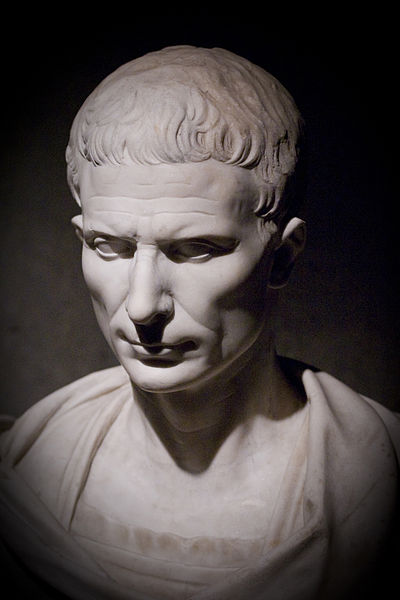

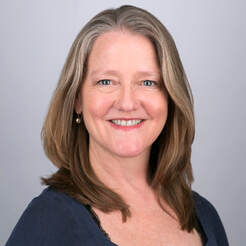

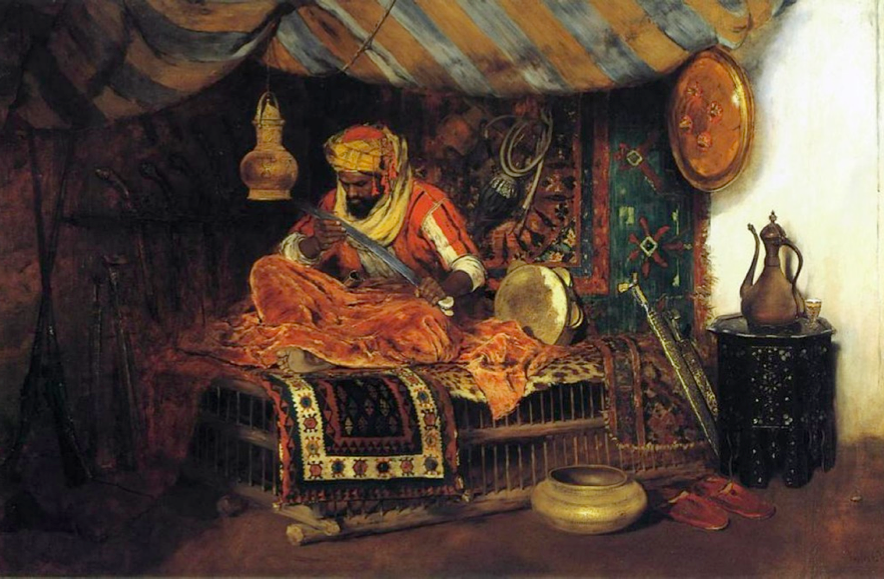








 RSS Feed
RSS Feed
